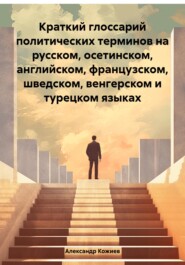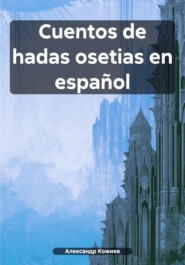По всем вопросам обращайтесь на: info@litportal.ru
(©) 2003-2025.
✖
Ossetian fairy tales in English
Настройки чтения
Размер шрифта
Высота строк
Поля
E e
Like e in end
E e
Come
????
Ю ю
Yu yu
Yu yu
???
Я я
Ya ya
Ya ya
???
About the author
Kozhiev Alexander Yurievi? – is a postgraduate student of MEPhI, a teacher of Arabic at the Foreign Language Learning Center (FLLC) of the Diplomatic Academy of the Ministry of Foreign Affairs of the Russian Federation. Graduated from:
– Diplomatic Academy of the Ministry of Foreign Affairs of the Russian Federation, during the studies mastered Arabic and French languages;
– National Research Nuclear University MEPhI, confirmed knowledge of Spanish;
– MGIMO of the Ministry of Foreign Affairs of the Russian Federation (double-degree Master's program with the Italian University of Cagliari), confirmed knowledge of Italian and German languages.
Educated in economics and politics, I still find myself looking back at Ossetian folk art. Ossetian fairy tales and tales have left the greatest imprint on me. These works should not be understood literally, but allegorically, because so much wisdom is hidden even where it seems to find little. All works of Ossetian literature are written in an allegorical way, and the reader has to guess it for him/herself.
I decided to write Ossetian fairy tales in English to better popularize Ossetian literature on a global scale. This will not only preserve cultural heritage, but also bring the wisdom of works of Ossetian folklore to a wider audience, opening new horizons for understanding and perception of Ossetian culture. Subsequently, Ossetian tales will be translated into other foreign languages (Arabic, Persian, French, Spanish, Portuguese, German, Swedish and Hungarian).
Kozhiev George Yurievi? provided great help in collecting Ossetian fairy tales, recording them, as well as in editorial work, thanks to which we can enjoy the narration from the words of elderly people who talked about previously unwritten fairy tales.
Introduction
Ossetian tales are a wonderful world where the history, culture and philosophy of the people are intertwined. They are an integral part of Ossetian spirituality and are passed on from generation to generation, retaining their relevance and significance.
The Nart Saga is the crown jewel of Ossetian oral folk tradition. These epic poems recount the exploits of the Narts – heroic characters with supernatural powers. The Narts symbolize strength, wisdom and justice, and their stories inspire and teach.
Among the characters, Soslan (a fearless warrior known for his strength and skill), Batraz (a wise man and advisor whose words are always full of deep meaning) and Satana (a female warrior symbolizing a mother and protector) are particularly prominent.
Nart Saga will not appear in this edition, as it requires more detailed consideration. In this collection of Ossetian tales you will encounter the Ossetian worldview and stories that are useful for children and adults alike.
Ossetian fairy tales carry a deep philosophical meaning. They teach respect for elders, love for the motherland, the value of friendship and brotherhood. Each fairy tale is not just a story, but a life lesson that helps to shape the moral values and identity of the people.
These tales are not just a literary heritage, they are a living source of wisdom that continues to influence Ossetian culture and art. Their importance cannot be overestimated, as they help preserve the uniqueness and identity of the Ossetian people.
It is also important to note that Ossetian fairy tales are not only a national treasure, but also an important part of the world's cultural heritage. They take us back to an ancient era when wisdom was passed on through oral stories, and every word had weight.
The international significance of Ossetian fairy tales lies in their universality and timelessness. They touch upon themes that are relevant to people of all cultures:
– The struggle between good and evil – an eternal theme that never loses its relevance.
– Strength of character and fortitude – qualities that are valued in any society.
– Respect for nature and ancestors – a reminder that we must protect the world around us and remember our roots.
The hidden meaning of Ossetian tales suggests that wisdom has no boundaries. It penetrates through centuries and peoples, enriching the human experience. These tales teach us to appreciate the world we live in and the people we share it with.
Ossetian fairy tales are a symbol of how culture can be a bridge connecting different eras and peoples. They show that wisdom and knowledge are what make us truly human, and that they should be preserved and passed on to future generations.
Ossetian tales and fairy tales are rich in a variety of characters, each with a unique role and meaning. The main characters are aldars (wise elders or ancestors who often act as mentors and counselors. They symbolize a connection to the past and the transmission of knowledge), animals (in Ossetian tales, animals often have human traits and wisdom. They can be helpers of the heroes or even bearers of important messages), wizards and sorcerers (characters represent knowledge of secret sciences and magic. They can both help the heroes and become a source of trials), warrior heroes (brave and strong characters who protect their people and demonstrate valor and honor), nymphs and nature spirits (mystical beings who represent the forces of nature and can both help and hinder the heroes), giants and monsters (trials for the heroes, symbolizing the overcoming of difficulties and inner fears), and ordinary people (peasants, artisans, who represent everyday life and often become unexpected heroes of fairy tales). Each character contributes to the development of the plot and the education of the listener or reader, as they help to convey the deep meaning embedded in the tales, making them a valuable source of knowledge and life lessons.
Ossetian tales and myths have much in common with Iranian, Indian and European traditions, reflecting common archetypes and motifs that are common to many cultures. Let us present just a few of these similarities:
Heroic figures: All these traditions have heroes who perform feats and protect their people, reminiscent of Rustam from the Iranian epic “Shahnameh” or bogatyrs from Slavic mythology.
Wise elders: Characters like Aldars in Ossetian tales are similar to the sages and mentors of other cultures, such as Vasishtha in Indian epics or Merlin in English legends.
Mystical creatures: Nymphs and nature spirits resemble characters from Greek mythology and European fairy tales, as well as apsaras from Indian mythology.
Villains and monsters: The giants and monsters that appear in Ossetian tales have analogs in the myths of the Cyclopes, the demon Rakshasas and various European dragons and trolls.
These similarities point to common human themes and universal stories that resonate across cultures despite geographic and language barriers. Characters and plots reflect universal values, fears, hopes and dreams that are part of the human experience around the world.
Let's quickly familiarize ourselves with our fairy tales!
How a mouse got married
Once upon a time, there was a mouse. It occurred to him to get married. He was very proud, so all mouse girls seemed unworthy to him. He was looking for the daughter of someone stronger than him.
So he went to the Moon, about whom it was said that there was no one stronger than him in the world.
– “Moon!”, – he said to him. “I am looking for the daughter of the strongest man in the world. They say in our land that there is no one stronger than you, and I would like to be related to you.”
– “Yes”, – the Moon answered to him. “I am strong beyond words, and there is no place or nook on earth where my light does not penetrate when I walk across the sky at night. But when the Sun rises in the morning, my light gradually dims and finally disappears. Only in the evening, when the Sun goes down and its light ceases to shine on the earth, does my power return to me and I illuminate the vast earth again. No, mouse, the Sun will be stronger than me: go to him!”
So the mouse went to the Sun.
– “Sun”, – she said to him. “I am looking for the daughter of the strongest man in the world to marry. And there is a rumor that you are the strongest in the world. Will you give your daughter for me?”











